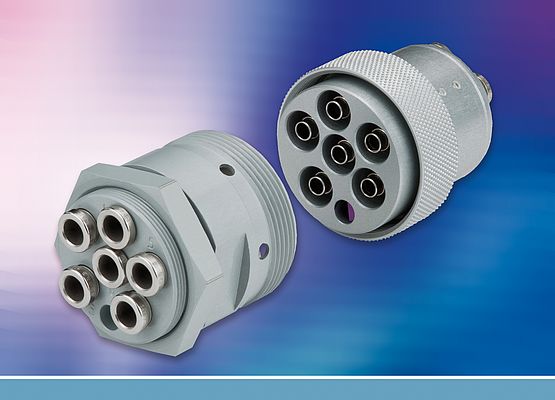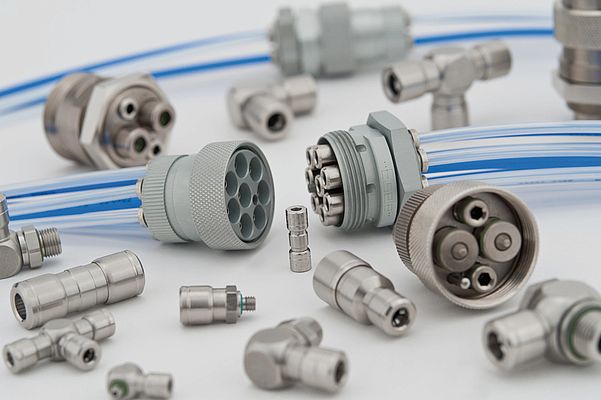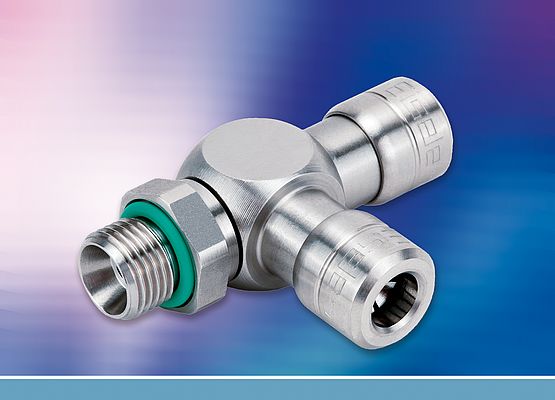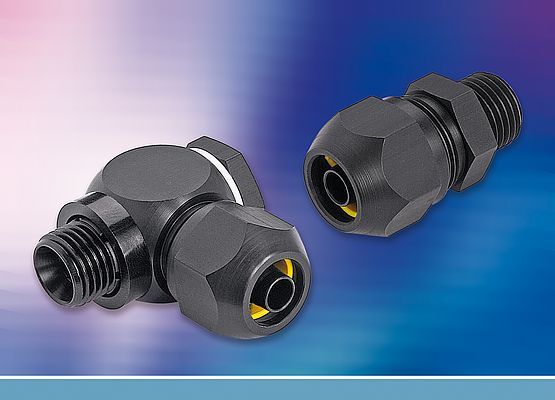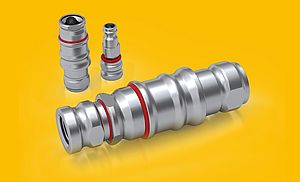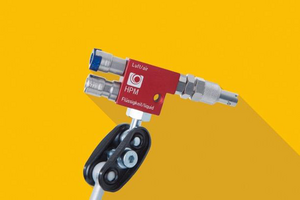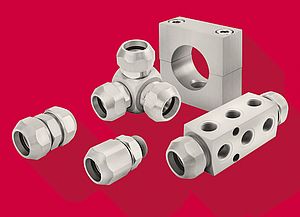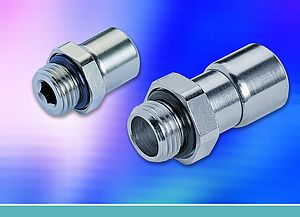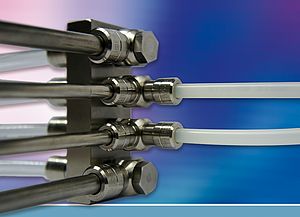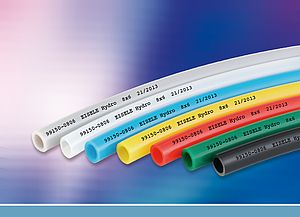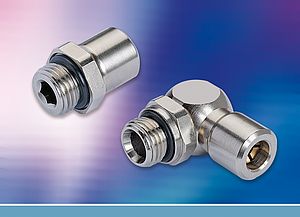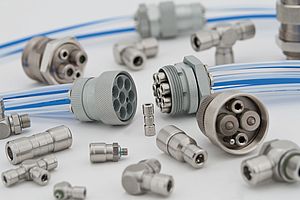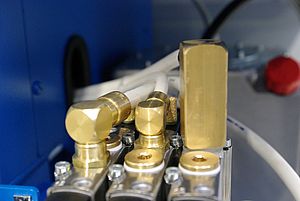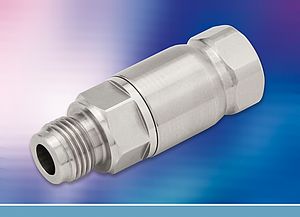In industrial applications, vacuum is used in handling technology, the semiconductor industry or, for example, in the manufacture of displays. The efficiency and reliability of vacuum applications depends on their stability. Even small leaks result in collapse of the vacuum and, consequently, failure of the application. Special attention must therefore be given to the quality of the connecting components on the connectors and threads of hoses and pipes. With high-quality vacuum-capable components from Eisele, leaks can be reliably prevented.
It is doubtful whether Otto von Guericke was aware of the diversity of possible applications for vacuum when he invented the first vacuum pump in 1650 and later demonstrated the existence of vacuum in spectacular experiments - the progress made in manufacturing technology up to the present day is simply too incredible. But without his early discovery, many modern applications would not even be possible. Semiconductors, computer displays and such seemingly simple applications such as the handling of components with vacuum grippers require a reliable and stable vacuum. Von Guericke's historic experiment with the Magdeburg hemispheres demonstrates the Achilles heel of the vacuum: The normal atmospheric pressure exerted such a force on the evacuated hemispheres that two teams of eight horses could not tear them apart. On the other hand, a tiny leak is all it takes for the vacuum to immediately fill with ambient air, so that it literally collapses.
Vacuum is more demanding than compressed air
The sealing requirements for vacuum applications are much higher than in normal pneumatic applications, in which a certain leakage rate, although not desirable, can at least be tolerated. In vacuum applications, even small leaks would endanger the entire process, since the required end vacuum could not be achieved reliably and stably. That is exactly why the connections and fittings have to fulfil high requirements. A clear advantage of Eisele quality becomes obvious here: All surfaces are extremely smooth and free of burrs, and all sealing surfaces feature a very high degree of plane parallelism, which prevents the occurrence of incorrect positions during tightening.
High-quality positioning and gripping
High-quality connecting technology with minimal leakage rates is the trademark of Eisele. The manufacturer, with production facilities exclusively at the company headquarters in Waiblingen, commissioned an independent comparison to confirm the leakage rates of the different product lines. Especially in vacuum applications, the rates achieved by Eisele products are unmatched. Due to these results, major automobile manufacturers have already decided to use connection technology from the Swabian company.
All Eisele connections are leakproof throughout the entire seal area. They are also easy to install and remove and easy to clean. This point is important for vacuum applications in handling technology, so that no dirt particles are drawn into the air flow, because they can clog the actuators.
Vacuum grippers can be used to achieve short cycle times and flexible processes in handling and pick-and-place applications, since the vacuum is available immediately, with no build-up time. Vacuum grippers also enable fast changeover to other processes, workpieces or products, because no fixed gripping position is defined - instead, the workpieces are lifted using suction cups. This eliminates the need for specific format sets on the robot or machine, which is especially advantageous in industries with frequently changing workpiece geometries.
Also, smooth and sensitive surfaces can be gripped securely and gently, so that damage as a result of automated handling is practically impossible. In glass production, for example, vacuum grippers are used successfully to prevent scratches during handling and in metalworking, they prevent warping or denting of thin metal sheets. In summary, the low-impact, flexible handling and the high process dynamics are the most important arguments for the use of vacuum in handling technology.
Plug-in hose connections
The right products for use in vacuum applications are the series 14, 14A and 10 of the Eisele BasicLine as well as the multiple connectors of the MultiLine. Series 14 and 14A consist of plug-in connectors with a release sleeve and one or two seals. They are available in different types, including straight, angle, double or T-connections. The type with a release sleeve allows safe disconnecting even after long periods of operation, since the sleeve protects the gripping jaws inside the housing.
To guarantee the high quality of the plug-in connections, the seal was equipped with a sealing ring. This sealing ring consists of an inner soft elastomer part and an outer nickel-plated brass ring. Due to this design, the hard ring absorbs the torque and the seal remains intact independent of this, so that accidentally pulling too firmly has no effect. Series 14 is suitable for an operating pressure range from -0.95 to 16 bar and temperatures from -20 to +80 degrees Celsius, while series 14A can be used up to 24 bar and +120 degrees Celsius.
More reliable due to threaded connection
Series 10 of the Eisele BasicLine (Screw joints with union nut) offers special protection against vacuum leakage. Its decisive advantage is that the hose connections are threaded instead of plug-in connections. The connections of the outer hose therefore do not loosen as easily and cannot accidentally be pulled loose. A fixed connection system ensures sealing against vacuum leaks for many years and also at high temperatures. High temperature resistance for example is a major advantage in the handling of hot plastic parts. The immediate availability of the vacuum also makes it possible to implement very fast pick-and-place cycles. In injection moulding, it is often necessary to produce many different shapes in fast succession. Vacuum grippers pick up these parts without having to change the system setup, because no fixed gripping position is defined. Vacuum technology therefore allows high flexibility in production. That is why this technology is also used in woodworking, for gripping and lifting panels of different shapes.
Multiple connectors for fast connections
One of the megatrends of our time is modularisation, which is also relevant for machine and plant engineering. Large plants are increasingly being designed as modular systems. Multiple connectors make it possible to implement very transparent and standardised interfaces between system components or modules. This allows thorough testing of assemblies prior to delivery and commissioning. On-site commissioning is then also simplified, through the well-known plug & play principle. The capability of easily exchanging or replacing entire modules facilitates maintenance and reduces setup times.
The 1811 series consists of the MultiLine multiple connectors, which create a reliable connection of four to twelve hoses with only a few turns of the hand. The plug and socket intuitively are connected correctly, so that no positioning pins are needed for this series. In the vacuum-suitable version this type is equipped with a shut-off, on either the plug or socket side. The shut-off valves make it possible to connect or disconnect the MultiLine connections also during operation. The couplings are manufactured using anodised aluminium; on request, versions are also available in stainless steel and nickel-plated brass. MultiLine features special springs designed for use in vacuum, in the pressure range from -0.8 to 0 bar.


